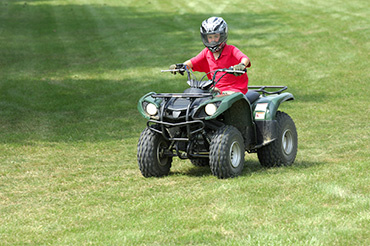Off-Road Vehicles Safety

Definition: Off-road vehicles (ORVs) are any three-or four-wheeled vehicle that has a motor and is designed for riding on unpaved surfaces. Examples of ORVs include All-Terrain Vehicles (ATVs), snowmobiles, jet skis, and motor bikes.
Magnitude of the Problem
According to the U.S. Consumer Product Safety Commission:
- 55 children under the age of 16 died in 2010 as a result of ATV-related injuries, representing 17% of all ATV-related deaths.
- 47% of these child deaths occurred in children younger than 12
- An estimated 14,100 children under age 12 were injured in ATV-related incidents in 2010. This accounts for 12% of all ATV-related injuries.
According to the American Academy of Pediatrics:
- In 1997, 12,600 people were injured as a result of snowmobiles
- 18% were children under 14 years of age
- 48% were ages 15-24
- 43% of pediatric snowmobile-related injuries occurred on private property where snowmobile use restrictions do not apply
Prevention
Some States have passed laws related to ATVs and youth, such as mandating the use of safety equipment; safety education courses; and minimum operator age requirements. Other prevention strategies include educating parents and youth about the skills needed to operate an ATV, the importance of supervision based on developmental skill level, personal protective equipment, having an ATV that is appropriate to the size of the operator, and the dangers of having passengers on ATVs.
Few States have enacted snowmobile-related age restrictions or helmet laws. Children as young as 8 years old may legally operate a snowmobile in some States. Age restrictions, graduated licensing, and safety education courses would also be an appropriate intervention to preventing snowmobile related injuries and fatalities in children and youth.
Drowning Prevention courses can be useful for teaching safety skills for jet skiers and preventing injury.